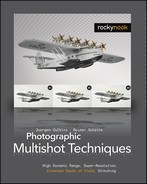Book Description
Photographers are just beginning to realize the potential of high dynamic range imaging (HDRI). Now, the newest techniques based on a bracketed series of exposures make it possible to go beyond HDRI: photographers can increase resolution for ultra-sharp, detailed images, and they can extend the depth of field in a way that was never before possible.
Photographic Multishot Techniques provides a thorough introduction and is a hands-on guide to these various techniques. Using a series of example images, the authors explain and illustrate the use of each technique. Included are lessons on HDRI, super-resolution, focus stacking, and stitching images. Moreover, the reader will learn how to effectively combine these various techniques to create amazing images.
Throughout the book, the authors use tools such as Photoshop, PhotoAcute, Photomatix Pro, FDRTools, CombineZM, DOP Detail Extractor, and Helicon Focus to illustrate the workflow with detailed, step-by-step instructions. Most of these tools offer free trial versions that are available for download at the Rocky Nook Website at the book description of "Photographic Multishot Techniques".
Learning to use these cutting-edge techniques is sure to expand the repertoire and improve the photographic skills of the professional, as well as the advanced amateur, photographer.
Table of Contents
- Cover Page
- Title Page
- Copyright Page
- Contents
- 1. Introduction
- 2. The Multishot Workflow
- 3. Super-Resolution – More Pixels
- 3.1 Super-Resolution Shooting Technique
- 3.2 Preparing Images for Use with PhotoAcute
- 3.3 PhotoAcute: Basic Usage
- 3.4 Creating Super-Resolution Images
- 3.5 Additional PhotoAcute Image Correction Functions
- “Correct Image Geometry” – Correcting Lens Distortion
- “Fix Color Fringing” – Correcting Chromatic Aberrations
- 3.6 Batch Processing
- 3.7 Import and Export Formats
- 3.8 Post-Processing Your Images
- 4. Focus Stacking – Maximizing Depth of Field
- 4.1 Why Use Focus Stacking?
- 4.2 What to Consider While Shooting
- 4.3 Shooting for Focus Stacking
- 4.4 Focus Stacking Using Photoshop
- 4.5 Focus Stacking Using PhotoAcute
- 4.6 Maximizing Depth of Field Using CombineZM
- 4.7 Focus Stacking Using Helicon Focus
- 4.8 Semi-Automatic Focus Stacking Using Photoshop CS4
- 4.9 Focus Stacking – A Summary
- 5. Stitching - Increasing Image Coverage
- 6. HDRI - Increasing Dynamic Range
- 6.1 High Dynamic Range Images and Tone Mapping
- 6.2 Shooting Techniques for HDR Images
- 6.3 Simple Photoshop Blending Techniques
- 6.4 Creating HDR Images Using PhotoAcute
- 6.5 Creating HDR Images Using Photoshop’s HDR Functionality
- 6.6 HDR Imaging Using Photomatix Pro
- 6.7 HDRI Using FDRTools
- 6.8 Which Program Is the “Right” One?
- 7. Enhancing Microcontrast
- A References and Links
- Index
- Footnotes
